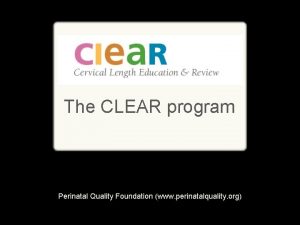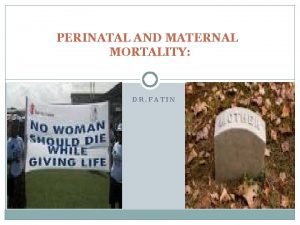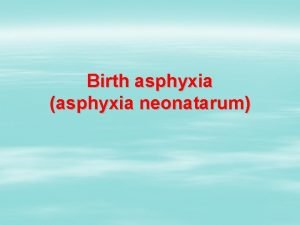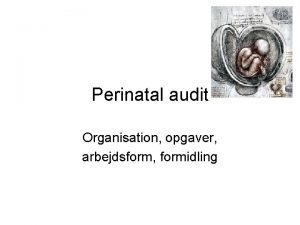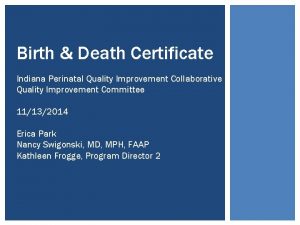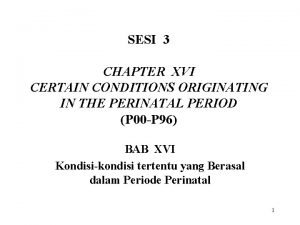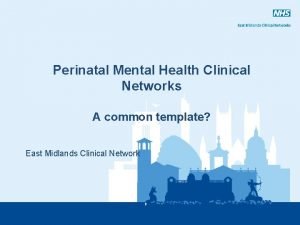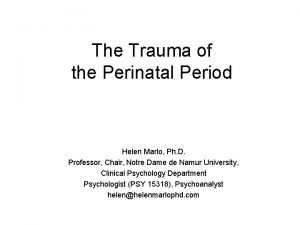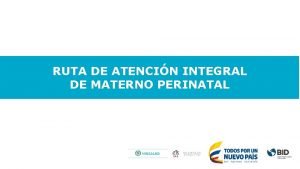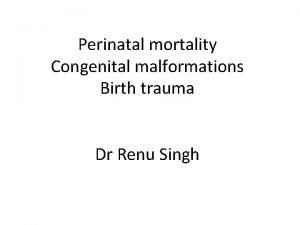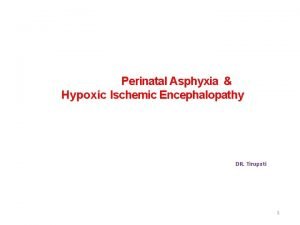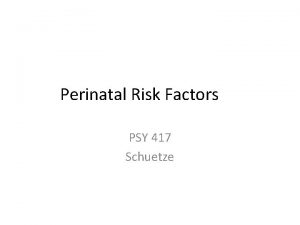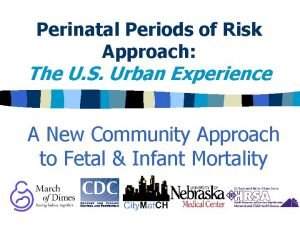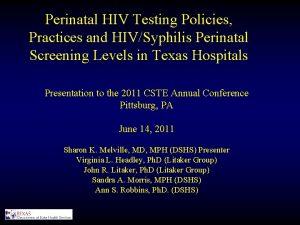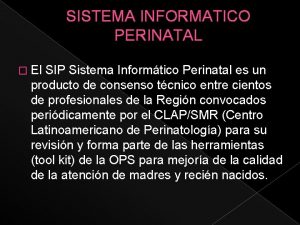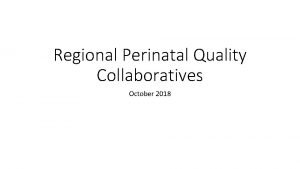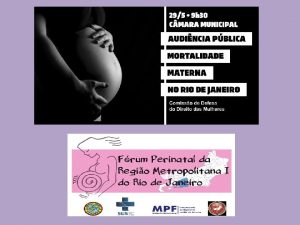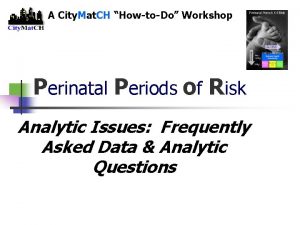Perinatal Periods of Risk Using Data and Community






















- Slides: 22

Perinatal Periods of Risk: Using Data and Community Involvement to Prevent Infant Mortality Introduction & Overview 1

INTERNATIONAL EXPERTISE Dr. Brian Mc. Carthy and colleagues at the Centers for Disease Control and Prevention and the World Health Organization knew that causes of perinatal death are closely related to both age at death and birth weight. ? u. Why not use both pieces of information to learn more about why babies are dying? 2

Experts used statistics to combine boxes with similar causes of death and risk factors Fetal Early Late Post. Deaths Neonatal neonatal Extremely Low Birthweight 500 -999 g Very Low Birthweight 1, 000 -1, 499 g Low Birthweight 1, 500 -2, 499 g 9 10 11 12 Normal Birthweight 2, 500 + g 13 14 15 16 Introduction & Overview of PPOR 3

Four Perinatal Periods of Risk named to suggest prevention areas Fetal Deaths >=24 wks 500 -1499 g 1500+ g Introduction & Overview of PPOR Neonatal Post neonatal Maternal Health / Prematurity 9 10 11 13 14 15 Maternal Care Newborn Care 12 Infant Health 16 4

The dividing lines had been chosen so deaths in the same “box” had similar PROBLEMS: • Causes of death • Maternal risk factors …which means they also had similar SOLUTIONS. 5

Each period of risk is associated with its own set of risk and prevention factors Maternal Health / Prematurity Preconception Health Behaviors Perinatal Care etc. Maternal Care Prenatal Care High Risk Referral Obstetric Care etc. Newborn Care Perinatal Management Neonatal Care Pediatric Surgery etc. Infant Health Sleep-related Deaths Injuries Infections etc. 6

They calculated the rate for each period of risk the same way, using the same denominator 97 Maternal Health/ Prematurity (4. 2 ) 48 44 47 Maternal Care Newborn Care Infant Health (2. 1 ) (1. 9 ) (2. 0 ) Urban County PPOR “map” 7

“What rates can we expect to see in each Period of Risk? ” PPOR answers this question using a reference group, a real population of mothers that experience best outcomes: low fetal and infant mortality rates. 8

The Reference Group is about Justice • The underlying assumption is that if the reference group can have low mortality, our study group should be able to reach that goal. Community stakeholders choose the reference group. They agree that it is an appropriate standard or goal for their community. 9

The difference between rates, or the “gap”, represents “excess mortality” and it means that some of the deaths were preventable. Urban County Reference Group 4. 2 2. 1 1. 9 Gap 2. 2 2. 0 1. 5 1. 1 2. 0 0. 9 = 0. 6 0. 8 1. 1 10

SUCCESS! They had eliminated many potential causes and narrowed the scope of their investigation Maternal Health / Prematurity Preconception Health Behaviors Perinatal Care etc. Maternal Care Prenatal Care High Risk Referral Obstetric Care etc. Newborn Care Perinatal Management Neonatal Care Pediatric Surgery etc. Infant Health Sleep-related Deaths Injuries Infections etc. 11

There are three helpful steps in Phase 2 Analysis 1. Identify the most important probable causes or mechanisms for excess mortality 2. Examine risk factors for those causes, by comparing the study and reference populations 3. Estimate potential impact of risk factors 12

Phase 2 Analysis Example for the Infant Health Period of Risk There are many common causes of death in the Infant Health Period of Risk SIDS/SUID Suffocation Drowning Car accidents Assault Infections Congenital anomalies etc. Step 1 is to find out which of these are causing excess mortality in our community. 13

Step 1. The dozens of ICD-10 codes were grouped, and mortality rates calculated for each group in both the study and reference populations. 14

Phase 2 Analysis Example for the Infant Health Period of Risk There are many common causes of death in the Infant Health Period of Risk SIDS/SUID Suffocation Drowning Car accidents Assault Infections Congenital anomalies etc. They had eliminated causes that were not large contributors to their excess infant mortality, and further narrowed the scope of their investigation. 15

Step 2: In Urban County, how common are the known risk factors for sleep related deaths? Compare study and reference groups if possible. Sleep position Maternal smoking Passive smoke Bedding Co-sleeping Crib availability and use Parental substance abuse Death scene investigation 16

Step 2: Since more mothers in Urban County smoked, this could be contributing to the gap. Percent Smokers (Birth Certificate) 18 16 14 12 10 8 6 4 2 0 Urban County US Reference Group 17

Step 2: Over 70% of Urban County babies were put to sleep on their backs, which is as good as the best states. Prone sleep position is less likely to be contributing to the gap. 18

Step 2: Other important information Child abuse investigators on the team reported that couches, blankets, and parental drug use had been factors in several “SIDS” death cases. A survey of local obstetricians revealed that • Most doctors did not discuss safe sleep with expectant mothers • Most were not aware of available smoking cessation services 19

Step 2: Guided by PPOR findings, the Fetal Infant Mortality Review team focused on Sleep-related deaths for six months. The FIMR Case Review Team reported that the physical and mental health of mothers was a factor in many of these deaths, including • chronic stressful conditions • lack of social support 20

The stakeholders weighed the evidence and sought more information as needed. Phase 2 investigations can continue as questions arise and more data becomes available 21

SUCCESS in Outcomes PPOR 1993 -2009 Urban County Fetal-Infant Rate=10. 7 Fetal-Infant Rate=10. 3 4. 0 2. 3 1. 4 The decrease in mortality rates can’t necessarily all be attributed to PPOR 2. 9 1993 -1996 Fetal-Infant Rate=8. 8 4. 1 2. 5 1. 8 1. 9 1997 -2000 Fetal-Infant Rate=8. 2 3. 5 1. 9 1. 4 2. 0 2001 -2005 3. 9 2. 0 1. 3 2006 -2009 22
 Standing around crying
Standing around crying Liquidity measures
Liquidity measures Clear perinatal quality
Clear perinatal quality Perinatal matrices grof
Perinatal matrices grof Fatin organ
Fatin organ Classification of birth asphyxia
Classification of birth asphyxia Neonatarum
Neonatarum Perinatal audit
Perinatal audit Perinatal anoksiya
Perinatal anoksiya Indiana perinatal quality improvement collaborative
Indiana perinatal quality improvement collaborative Certain conditions originating in the perinatal period
Certain conditions originating in the perinatal period Ccqi perinatal standards
Ccqi perinatal standards South dakota perinatal association
South dakota perinatal association Perinatal period
Perinatal period Ruta materno perinatal
Ruta materno perinatal Subgaleal hemorrhage
Subgaleal hemorrhage Levene staging
Levene staging Residual risk and secondary risk pmp
Residual risk and secondary risk pmp Business risk and financial risk leverage
Business risk and financial risk leverage Attributable risk
Attributable risk Attributable risk formula
Attributable risk formula Using risk to balance agile and plan driven methods
Using risk to balance agile and plan driven methods Topic 15 periods authors and genres
Topic 15 periods authors and genres


